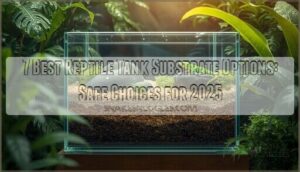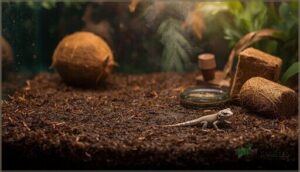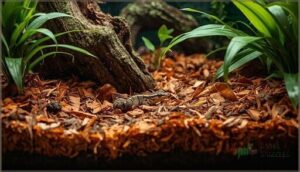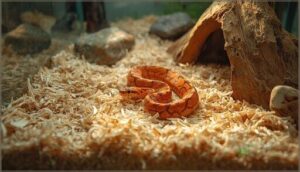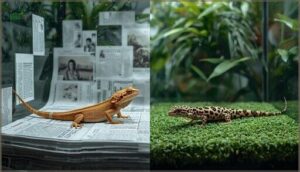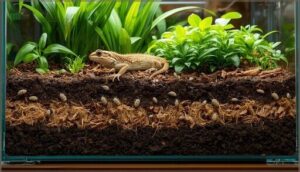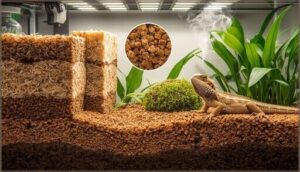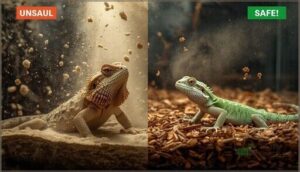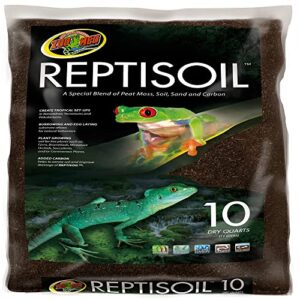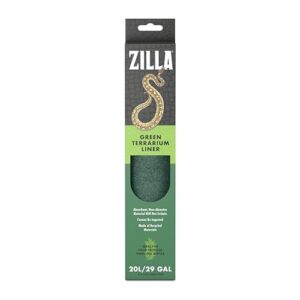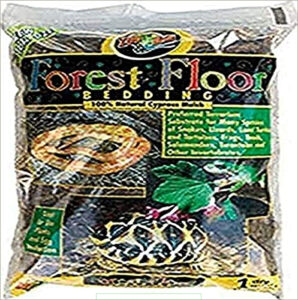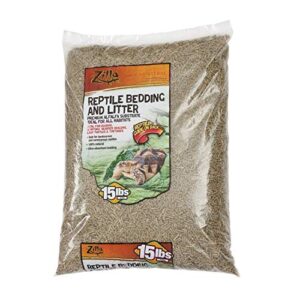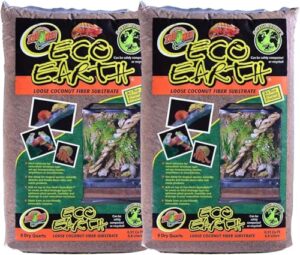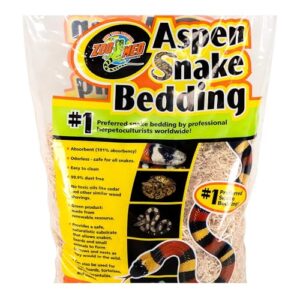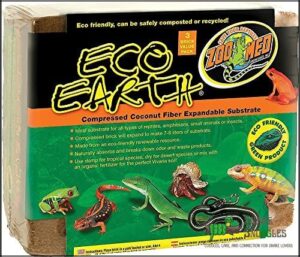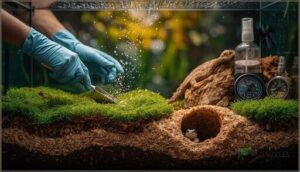This site is supported by our readers. We may earn a commission, at no cost to you, if you purchase through links.
Your reptile’s substrate isn’t just bedding—it’s the foundation of their entire environment. Choose poorly, and you’re setting the stage for respiratory infections, impaction, or chronic stress. Choose wisely, and you’ll create a habitat where your pet thrives naturally.
The challenge? With dozens of reptile tank substrate options flooding the market, each claiming to be “perfect,” sorting the safe from the risky can feel overwhelming. Desert species need bone-dry materials, while tropical geckos require moisture-retentive bedding that holds humidity without fostering mold.
Understanding what your specific reptile needs—and which products actually deliver—makes the difference between a healthy pet and expensive vet visits.
Table Of Contents
Key Takeaways
- Substrate choice directly impacts reptile health—wrong materials cause impaction (40% of emergencies), respiratory infections (90% from dusty bedding), and chronic stress, while proper selection prevents expensive vet visits and supports natural behaviors like burrowing and shedding.
- Match substrate to your reptile’s natural habitat: desert species need low-moisture options with excellent drainage (30-40% humidity), tropical species require moisture-retentive materials like coconut fiber (60-80% humidity), and burrowing species need 8-12 inches of depth to display natural digging behaviors.
- Coconut fiber, cypress mulch, and aspen shavings are top performers for different needs—coconut coir holds moisture for days and supports bioactive setups, cypress mulch naturally controls odors through antimicrobial oils, and aspen’s 191% absorbency keeps dry-climate enclosures fresh with minimal dust.
- Daily spot cleaning removes 90% of waste before it impacts smell, full substrate replacement every 2-4 weeks prevents bacterial buildup and mold growth, and avoiding toxic materials like pine/cedar shavings, cat litter, and walnut shells eliminates preventable health crises.
Factors to Consider When Choosing Substrate
Choosing the right substrate isn’t just about grabbing whatever’s on sale at the pet store. You need to match the material to your reptile’s natural habitat, health needs, and daily behaviors.
Let’s walk through the key factors that’ll help you make a safe, practical choice for your setup.
Species-Specific Requirements
Choosing the right substrate starts with your reptile’s natural habitat. Desert species like Uromastyx need low-moisture options with excellent drainage, while tropical geckos thrive in moisture-retentive coconut fiber.
Consider these species-specific substrate needs:
- Desert substrate: Sand-gravel blends for bearded dragons (30–40% humidity)
- Tropical substrate: Organic soil mixes for high-humidity species (60–80%)
- Aquatic substrate: River stones for turtles (grain size >3mm)
- Snake substrate: Aspen bedding preferred by 85% of keepers
- Burrowing species: Deep bedding (>10cm) increases natural behaviors by 30%
Substrate selection for reptiles depends entirely on matching your pet’s biological requirements. For example, ceramic tile is recommended for bearded dragons.
Humidity and Moisture Retention
Humidity regulation matters just as much as species selection. Moisture retention directly impacts your reptile’s shedding, respiration, and overall health.
Coconut coir holds 8–10 times its weight in water, creating humidity gradients of 60–85% for tropical species. Cypress mulch elevates humidity by 20–30% above room levels, while reptile carpet offers minimal humidity control.
Substrate layering with drainage prevents mold, and proper misting frequency—every 24–48 hours—maintains stable humidity levels without over-saturation. Maintaining ideal humidity levels helps guarantee proper reptile health.
Odor Control and Cleanliness
Substrate odor comes from anaerobic bacteria thriving in waterlogged layers and unmanaged waste. Absorbent substrates like coconut fiber and aspen shavings control substrate odor by supporting microbial activity that speeds waste decomposition.
Your cleaning schedule matters—daily spot cleaning removes 90% of waste before it impacts smell, while aerating substrate biweekly prevents bacterial buildup. Effective waste management through proper cleaning methods keeps your enclosure fresh and your reptile healthy.
Safety and Health Risks
Beyond cleanliness, substrate safety directly impacts reptile health. Impaction from ingesting loose bedding causes 40% of substrate-related emergencies, while dusty wood substrates trigger respiratory issues in 90% of exposed reptiles.
Substrate safety directly impacts reptile health—impaction causes 40% of emergencies, while dusty bedding triggers respiratory issues in 90% of exposed animals
Bacterial growth multiplies 300% faster on untreated organic materials, and mite infestations plague 17% of store-bought bark.
Chemical toxicity from treated substrates causes immune suppression—choosing safe options prevents these preventable health crises.
Aesthetic Preferences and Natural Look
Visual enrichment matters more than most people realize. Over 65% of you choose substrates that replicate wild habitat, and you’re right—naturalistic setups genuinely work.
Reptile enclosure aesthetics boost satisfaction by 72%, while habitat mimicry through color matching and layered designs increases natural behaviors by up to 80%.
Forest floor bedding, bioactive mixes, and textured substrates don’t just look better—they help your reptile thrive.
Budget and Availability
While premium substrates deliver results, your wallet doesn’t need to take a hit. Here’s how to balance cost with quality:
- DIY substrates using topsoil ($2.25/bag), sand, and organic materials slash expenses while matching retail performance
- Bulk discounts through online retailers reduce per-unit costs on coconut fiber and cypress mulch considerably
- Regional availability affects pricing—paper towels and newspaper offer free alternatives nationwide despite cost fluctuations in specialty materials
Common Types of Reptile Tank Substrates
You’ll find plenty of substrate options on the market, but not all of them are safe or practical for your reptile. The right choice depends on your pet’s natural habitat, moisture needs, and how much maintenance you’re willing to handle.
Let’s walk through the most common types you’ll encounter and what makes each one worth considering.
Coconut Fiber and Coconut Coir
If you’re looking for a substrate that checks multiple boxes at once, coconut fiber and coconut coir deserve your attention. This eco-friendly reptile substrate offers excellent moisture retention—maintaining 70–80% humidity for days after misting—and natural odor control that keeps enclosures fresh.
| Feature | Benefit |
|---|---|
| Coir moisture retention | Fulfills tropical species’ needs |
| Burrowing support | Encourages natural digging behavior |
| Coir sustainability | Biodegradable and compostable |
The loose texture allows your reptile to burrow safely while presenting minimal impaction risk compared to sand. You’ll find compressed blocks widely available for $4–$9, making this a practical choice for ball pythons, geckos, and similar species.
Cypress Mulch and Bark Chips
Cypress mulch and bark chips deliver impressive moisture retention for tropical and burrowing species while naturally controlling odors through antimicrobial oils. You’ll appreciate their pest resistance and reusable nature, though safety concerns warrant attention.
- Cypress mulch sustains elevated humidity for hours after misting
- Natural oils inhibit bacterial growth and mask enclosure odors
- Loose texture encourages safe burrowing in 4–8 inch depths
- Watch for ingestion risks—large pieces may cause impaction
- Avoid pine or cedar; cypress contains lower toxic phenol levels
Aspen Shavings and Wood-Based Bedding
Aspen shavings offer outstanding absorbency rates of 191%, meaning you’ll handle fewer substrate changes while maintaining a drier enclosure. This wood-based bedding provides enhanced burrowing support for species like corn snakes and king snakes, and it’s 99.9% dust-free for respiratory safety.
| Feature | Benefit |
|---|---|
| Odor minimization | Naturally controls smells without aromatic oils |
| Chemical safety | Free from toxic phenols found in cedar or pine |
| Sustainable sourcing | Renewable, biodegradable wood products |
However, check unopened bags for mold spores—heat treatment reduces this risk. Aspen works best for species requiring moderate humidity, as its absorbency can make maintaining tropical moisture levels challenging.
These safe options excel in dry to moderate environments where substrate safety considerations and natural burrowing behaviors matter most.
Reptile Carpet and Newspaper
When budget-friendly reptile bedding matters most, newspaper and reptile carpet offer distinct advantages as safe options for tank liners. Consider these practical points:
- Cleaning frequency: Newspaper needs weekly replacement, while carpet lasts years with weekly washing
- Moisture retention: Both lack humidity provision for tropical species
- Behavioral enrichment: Neither substrate encourages natural burrowing behaviors
Watch for entanglement hazards with carpet fibers that can snag claws. Cost comparison favors newspaper initially, though carpet’s longevity balances long-term expenses.
Bioactive Setups With Topsoil Mix
For keepers ready to move beyond simple liners, bioactive setups with topsoil mix offer considerable benefits. These systems combine organic topsoil with coconut coir, supporting plant growth and housing beneficial microbes that accelerate waste breakdown by 30%.
You’ll need to verify your topsoil is pesticide-free—82% of commercial options contain contaminants. When properly layered at 4-8 inches depth, impaction risks stay below 3% in healthy reptiles.
Engineered and Treated Substrates
Antimicrobial substrates with sterilization treatments reduce bacterial contamination by over 70%, addressing hygiene concerns many keepers face. However, some treated options contain VOCs that release toxins when heated—particularly linoleum or certain shelf liners.
While engineered substrates offer moisture retention benefits and bioactive advantages, watch for oversized particles that increase impaction risks.
These innovations represent safe substrate options when you choose reputable brands, though substrate pros and cons vary by formulation.
Substrate Safety Considerations
Choosing the right substrate isn’t just about comfort—it’s about keeping your reptile safe from health hazards that can sneak up on even experienced keepers.
From impaction risks to respiratory irritants, certain substrate choices can create serious problems if you’re not careful.
Here’s what you need to watch for to protect your pet.
Preventing Impaction and Digestive Issues
Preventing reptile impaction starts with choosing substrates that minimize ingestion risk. Fine loose substrates like sand cause intestinal blockages in over 60% of reported cases, while newspaper and reptile carpet present negligible risk.
You’ll also need to maintain proper hydration—dehydration increases impaction risk by 40%—and feed outside the enclosure to reduce substrate ingestion by 70%. Regular preventive maintenance completes your safety strategy.
Avoiding Respiratory Irritants
Your snake’s air quality matters just as much as substrate ingestion risks. Fine particulate substrates increase airborne dust by 42%, causing respiratory issues in up to 55% of reptiles.
Pine and cedar shavings release aromatic oils that trigger breathing problems in 60% of exposed animals.
Choose low-dust options like coconut fiber or reptile carpet—they cut respiratory complications by 70% while maintaining safe VOC exposure levels.
Mold, Mites, and Bacterial Growth
Why do so many substrates harbor hidden dangers? Black mold signals poor airflow and bacterial buildup at humidity above 80%. Mite infestations thrive in neglected tanks, while snakes shed Salmonella in 56% of cases—posing zoonotic disease risks.
Replace substrate every 2–4 weeks for mold prevention and mite control. Clean waste immediately to maintain substrate hygiene and minimize bacterial growth.
Safe Substrate Depth and Usage
How deep should your substrate actually be? The answer depends entirely on species needs and burrowing depth requirements.
- Burrowing species (hognose snakes, blue-tongued skinks) need 4–6 inches minimum for natural digging behavior
- Non-burrowers thrive on 0.5–1 inch for waste absorption and cushioning
- Layering Benefits include improved drainage and reduced water stagnation
- Proper depth reduces Impaction Risks by preventing forced substrate ingestion during feeding
- Deeper substrates extend Cleaning Intervals in bioactive setups, supporting long-term reptile health and safety
Substrates to Avoid (Sand, Cat Litter, Walnut Shells)
Why are some substrates still sold if they’re hazardous? Sand impaction risks affect up to 40% of bearded dragons with blockages, while walnut shell toxicity from juglone causes tissue damage. Cat litter chemical hazards include pH swings and ammonia buildup.
These unsafe substrate options trigger respiratory problems and ingestion dangers. Substrates to avoid include calcium carbonate sand, processed litters, and crushed walnut shells—all preventable threats to your reptile’s health.
Top 7 Reptile Tank Substrate Products
Now that you know what to avoid and what features matter most, let’s look at seven substrate products that meet those safety and performance standards.
Each option works well for specific reptile needs, from moisture-loving species to those requiring drier environments. You’ll find choices here that balance safety, ease of maintenance, and your pet’s natural behaviors.
1. Zoo Med Reptisoil Bioactive Terrarium Substrate
Zoo Med Reptisoil brings bioactive benefits to life in your terrarium, combining humus, peat moss, sand, and carbon. This reptile substrate excels at moisture regulation while supporting tropical species like geckos and frogs.
The blend’s coconut carbon helps beneficial bacteria colonize, tackling persistent odors naturally. You’ll notice lower impaction risks compared to sand, though proper hydration prevents dusty conditions.
Usage guidelines recommend spot-cleaning daily and full replacement every 1–3 months. User feedback consistently highlights natural burrowing behaviors and healthy plant growth, making this bioactive substrate ideal for tropical terrariums and paludariums alike.
Best For: Reptile and amphibian keepers who want a bioactive terrarium setup with natural humidity control and healthy plant growth.
- Supports beneficial bacteria colonization through coconut carbon, which helps reduce odors naturally while maintaining a self-sustaining bioactive environment.
- Retains moisture effectively for tropical species like geckos and frogs, allowing animals to display natural burrowing and egg-laying behaviors.
- Lower impaction risk compared to sand substrates, and mixes well with other materials like coconut fiber or play sand for customized humidity levels.
- Can become dusty when too dry, potentially causing respiratory irritation for sensitive species unless properly hydrated and maintained.
- Requires regular maintenance including daily spot-cleaning and full replacement every 1–3 months to prevent mold or anaerobic buildup.
- Some batches may contain fine particles or occasional debris, and the “new formula” has received mixed feedback from long-time users.
2. Zilla Green Reptile Terrarium Liner
If you’re tired of constant bedding replacement, the Zilla Green Reptile Terrarium Liner offers a reusable alternative that balances convenience with reptile safety. This non-ingestible substrate features enzyme-treated polyethylene that reduces odors naturally while supporting safe movement for leopard geckos and bearded dragons.
You’ll spend less annually—up to 40% compared to disposable bedding—with a maintenance cycle of 1–2 months between replacements. The liner’s environmental impact stays low through recycled materials and biodegradable properties, making cost efficiency and sustainability work together in your terrarium setup.
Best For: Beginner reptile owners and those with juvenile pets like leopard geckos or bearded dragons who want a low-maintenance, cost-effective substrate that’s safe and easy to clean.
- Saves money over time with reusable design—cuts annual substrate costs by up to 40% compared to disposable bedding.
- Enzyme treatment naturally controls odors and reduces bacteria, keeping your terrarium fresher between cleanings.
- Non-ingestible material protects reptiles from impaction risks, especially important for juveniles prone to eating loose substrate.
- Needs replacement every 1–2 months to maintain odor control, which means you can’t just forget about it forever.
- Spot cleaning doesn’t always work well—hardened waste may require a full rinse and dry cycle.
- Some reptiles try to crawl underneath it, so you’ll need to secure edges properly in your setup.
3. Zoo Med Forest Floor Bedding
When your reptile needs a humid habitat that mimics a forest floor, Zoo Med Forest Floor Bedding delivers natural cypress mulch that holds moisture for up to 7 days between mistings. This substrate maintains 60–80% humidity for tropical species while supporting bioactive potential through beneficial bacteria growth.
User reviews average 4.3 stars across 2,800+ ratings, praising its longevity and burrow stability. You’ll need to feed your reptile outside the terrarium to prevent impaction risks from wood fragments, and replace the bedding monthly to control mold in moist conditions.
Best For: Reptile owners with tropical species like snakes, amphibians, or forest-dwelling tortoises that need consistent humidity and a natural substrate that supports burrowing.
- Holds moisture for up to a week between mistings, maintaining 60–80% humidity without constant attention
- Compatible with bioactive setups and lasts 30–45 days before needing replacement, making it cost-effective
- Made from 100% natural cypress mulch with no chemicals or dyes, reducing skin irritation risks
- Requires feeding outside the enclosure to prevent impaction from ingesting wood fragments
- Can develop mold if not replaced monthly or properly aerated in high-moisture conditions
- May arrive dusty or with large pieces that need removal before use
4. Zilla Alfalfa Meal Reptile Bedding
For herbivorous reptiles that occasionally nibble their bedding, Zilla Alfalfa Meal offers digestible pellets that won’t cause impaction if ingested. These compressed alfalfa pellets expand when wet, making spot cleaning straightforward—you’ll see exactly where waste sits.
The substrate works best at 1–2 inches deep in low-to-medium humidity setups for tortoises, iguanas, and bearded dragons. You’ll find 15-lb bags around $14–$15, though availability fluctuates online.
Replace bedding every three months to prevent mold in moisture-prone areas.
Best For: Herbivorous reptiles like tortoises, iguanas, and bearded dragons in low-to-medium humidity setups where occasional ingestion isn’t a concern.
- Safe if eaten—compressed alfalfa pellets digest easily and won’t cause impaction in herbivores.
- Expands when wet so you can spot waste instantly and clean only what’s needed.
- Ultra-absorbent with bacteriostatic agents to control odor and minimize germs between full changes.
- Gets moldy fast in damp areas—not ideal for high-humidity species or water-heavy enclosures.
- Strong farm smell that some keepers find off-putting compared to paper or coconut bedding.
- Requires full replacement every three months and daily spot cleaning to stay clean.
5. Zoo Med Eco Earth Coconut Fiber
If you need more versatility than alfalfa meal provides, coconut fiber delivers consistent moisture retention across tropical species. Zoo Med Eco Earth comes in loose or brick formats—each compressed brick expands to roughly 7–8 liters when you add four quarts of water.
You’ll find it holds 60–80% humidity for days without extra misting, making it ideal for rainforest inhabitants like tree frogs and green tree pythons. Research shows coconut fiber substrates noticeably reduce fecal odor compared to traditional bedding.
Spot-clean daily and replace everything every 4–6 weeks to prevent bacterial buildup.
Best For: Reptile and amphibian owners maintaining tropical setups who need reliable humidity control and natural odor management without constant misting.
- Expands significantly when hydrated (7–8 liters per brick) and holds 60–80% humidity for several days, reducing daily maintenance for moisture-loving species.
- Naturally absorbs and breaks down waste to control odors, with research showing measurable reductions in fecal smell compared to standard bedding.
- Fully biodegradable and compostable after use, so you can recycle it into garden soil instead of sending it to a landfill.
- Can dry out quickly in well-ventilated tanks, sometimes forming loose clumps that blow around the enclosure.
- Not suitable for arid species like leopard geckos or bearded dragons, as excess moisture can lead to respiratory issues or infections.
- Pricing varies widely ($4.90–$24.99 depending on format), and some users report receiving damaged packaging or incorrect quantities during shipping.
6. Zoo Med Aspen Snake Bedding
When dry conditions matter more than moisture, Zoo Med Aspen Snake Bedding delivers a 191% absorbency rating that pulls waste quickly from your tank floor. Corn snakes and hognose snakes thrive on its 99.9% dust-free shavings, which support burrowing without respiratory irritation.
The light color makes odor management simple—spot fecal matter fast and scoop it out. Replace bedding every 60–90 days, because even dry substrate harbors bacteria over time.
Just remember: aspen holds 40–60% humidity at best, and damp conditions trigger rapid mold growth, so reserve it for arid-species enclosures.
Best For: Snake owners with arid-species like corn snakes or hognose snakes who need absorbent, dust-free bedding that supports burrowing and makes waste easy to spot.
- 191% absorbency rating pulls moisture from waste quickly, keeping the tank floor dry and reducing odor between cleanings.
- 99.9% dust-free formula minimizes respiratory irritation while the light color makes spotting and removing fecal matter simple.
- Double-shredded texture supports natural burrowing behavior and lowers impaction risk if accidentally ingested during feeding.
- Only maintains 40–60% humidity, making it unsuitable for tropical or rainforest species that need sustained moisture above 60%.
- Prone to rapid mold growth when damp or used in humid climates, even in unopened bags according to field reports.
- Requires full bedding replacement every 60–90 days to prevent bacterial buildup, adding to long-term maintenance costs.
7. Zoo Med Eco Earth Substrate
Zoo Med Eco Earth Substrate flips the script—each compressed brick expands to 7–8 liters with water, giving you coconut fiber that holds humidity above 70%.
Ball pythons and red-eared sliders use it for burrowing and egg-laying, while the coir naturally breaks down waste and controls odor for 30 days between full changes.
At $18–$30 for three bricks, you’re paying about $2.50 per setup. Just keep it moist—dry coconut coir kicks up dust that irritates lungs and eyes.
Best For: Reptile and amphibian owners who need affordable, humidity-retaining substrate for burrowing species like ball pythons, red-eared sliders, or tropical setups.
- Expands to 7–8 liters per brick when hydrated, making it cost-effective at around $2.50 per terrarium setup with three-brick packs running $18–$30.
- Maintains terrarium humidity above 70% and naturally breaks down waste while controlling odor for up to 30 days between full substrate changes.
- Eco-friendly and compostable after use, plus it’s safe if accidentally ingested in small amounts since it dissolves in water.
- Becomes dusty when dry, which can irritate eyes and respiratory systems—requires regular misting to stay safe for animals.
- Needs daily maintenance and stirring to prevent uneven drying or becoming too wet, which can attract gnats in overly moist conditions.
- Not suitable for arid-dwelling reptiles like leopard geckos, and typically requires full replacement every 3–6 months depending on habitat size and animal load.
Substrate Maintenance and Best Practices
Choosing the right substrate is only half the battle—keeping it clean and functional is where your reptile’s health really depends on you. Proper maintenance prevents bacterial growth, controls odor, and encourages natural behaviors like burrowing and shedding.
Here’s what you need to know to keep your setup safe and thriving.
Cleaning and Replacement Frequency
Spot cleaning daily—removing waste and uneaten food—keeps your tank hygienic and prevents bacterial growth.
Full replacement depends on substrate type: reptile carpet needs weekly washing, while loose substrates like coconut fiber or cypress require changing every 2 to 4 weeks. Delaying substrate maintenance increases health risks, including respiratory infections and parasites.
Influencing factors like enclosure size and waste output determine your specific tank maintenance schedule.
Monitoring Humidity and Temperature
How do you know if your tank environment is actually what your snake needs? Digital hygrometers with probe placement at both ends reveal true humidity levels—often varying by 20% RH within one enclosure. Your substrate choice directly impacts these readings: coconut coir increases humidity by up to 25% compared to paper bedding.
Species needs vary widely; Ball Pythons thrive at 50%–60% RH, while Crested Geckos require 70%–80%. Maintaining proper humidity through control technologies and regular monitoring prevents respiratory infections.
Preventing and Managing Odors
What causes that telltale reptile tank smell? Odor-causing bacteria thrive when substrate oversaturation limits oxygen flow or organic decomposition outpaces waste management.
Daily spot cleaning paired with substrate maintenance every 2–4 weeks prevents buildup. Introduce microfauna populations like springtails in bioactive setups to accelerate breakdown.
Ventilation improvements measurably reduce airborne contaminants, while mineral-based substrates provide extended odor control between deep cleanings.
Supporting Burrowing and Shedding Behaviors
Your substrate acts as more than bedding—it’s the stage for critical natural behaviors. Burrowing substrate depth of 8–12 inches lets digging species like leopard geckos tunnel safely, while shedding humidity levels between 50–70% guarantee complete ecdysis hygiene.
- Stable tunnel structure prevents collapse, reducing stress in burrowing animals
- Moisture-retentive substrates aid snake shedding cycles and skin removal
- Inadequate depth triggers restlessness and suppresses natural digging behavior
- Daily humidity monitoring promotes Reptile burrowing habits and prevents retained skin
Eco-Friendly and Sustainable Substrate Choices
Choosing ecofriendly substrate options protects both your reptile and the planet. Coconut coir repurposes 10 million metric tons of husks annually, while bioactive benefits include 60% less waste replacement. Recycled paper bedding diverts 1,500 metric tons from landfills yearly. Certified mulch sourcing and moss solutions guarantee renewable practices.
Look for products like Eco Earth Compressed Coconut Fiber Expandable Reptile Substrate to support sustainable reptile care without compromising safety.
Frequently Asked Questions (FAQs)
Can I mix different substrates together safely?
Yes, you can mix substrate types if you match your species’ needs and sterilize materials first. Common ratios include 50/50 soil-sand blends, but always avoid sharp particles or impaction-prone substrate mixing options.
How much substrate depth do reptiles need?
Most reptiles need 2-4 inches of substrate depth. Burrowing species like bearded dragons require 8-12 inches to support natural digging behavior, while non-burrowing snakes manage well with shallower layers for humidity impact and temperature gradients.
Do substrates expire or go bad over time?
Like spoiled food left too long, substrates degrade through microbial contamination, mold growth, bacterial growth, and chemical degradation.
Physical changes increase impaction risks and respiratory irritation, making timely substrate replacement essential for substrate maintenance.
Are colored or dyed substrates safe for reptiles?
Dyed substrates pose serious reptile health and safety concerns. Dye chemical toxicity, leaching, and impaction risk from ingestion can cause skin pigmentation issues, behavioral changes, and internal toxicity.
Avoid colored materials—stick with natural, untreated substrate options instead.
Can I reuse substrate after deep cleaning it?
Reusing substrate is like trying to restore a worn sponge—sterilization methods may eliminate pathogens temporarily, but substrate integrity degrades, moisture retention falters, and bacterial growth risks return.
Fresh substrate ensures ideal hygiene and long-term substrate quality.
Conclusion
An ounce of prevention is worth a pound of cure—and choosing the right reptile tank substrate options is your first line of defense against preventable health issues. You’ve learned which materials support natural behaviors, which ones pose hidden risks, and how to match substrate to species.
Now it’s time to apply that knowledge. Your reptile depends on you to create a foundation where they don’t just survive—they thrive.
- https://exo-terra.com/explore/academy/substrates/
- https://www.visionproducts.us/blog/reptile-substrate/
- https://talis-us.com/blogs/blog-47/top-choices-for-best-substrates-for-reptiles-explained
- https://felasa.eu/Portals/0/Library/GT123(2004)_PART-B_Reptiles.pdf?ver=wCsqSCVu4NSRe8e6gqM_5Q%3D%3D
- https://www.theexaminernews.com/buying-guides/best-substrate-for-bearded-dragons/

